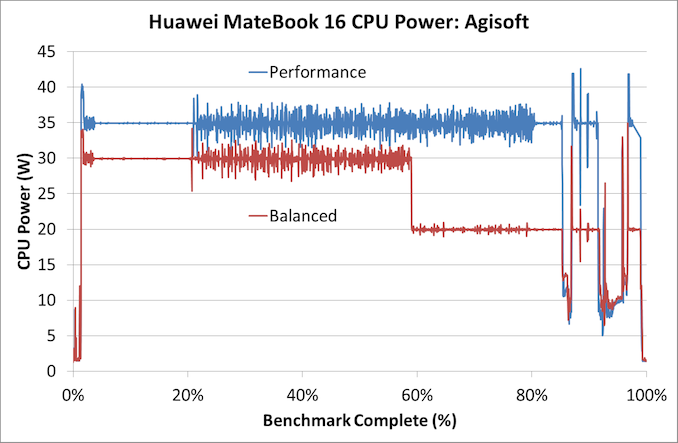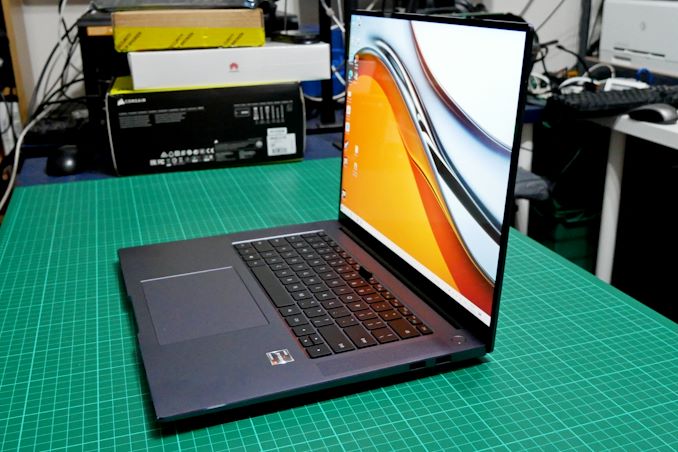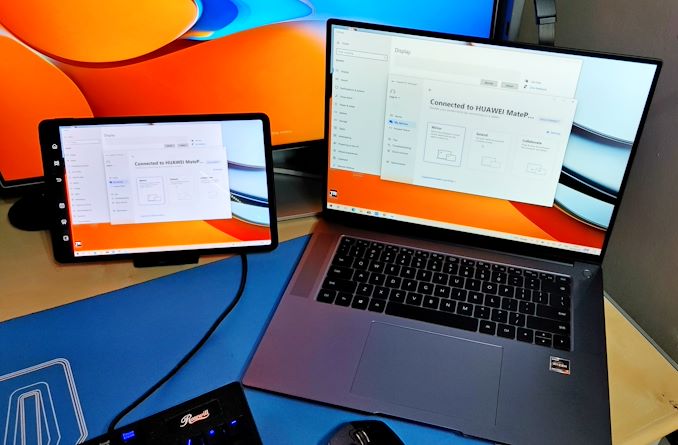The Huawei MateBook 16 Review, Powered by AMD Ryzen 7 5800H: Ecosystem Plus
by Dr. Ian Cutress on October 20, 2021 8:00 AM EST- Posted in
- Laptops
- AMD
- Huawei
- Matebook
- Ryzen
- Zen 3
- MateBook 16
- Huawei Share
- Ryzen 7 5800H
Huawei: Building its Ecosystem
From the 30000ft view, I’m a fan of notebooks that promise good power and battery life at the expense of graphics. As a journalist, when I’m on the move I need something that’s going to be easy to carry, easy to work on, and has enough juice to last me through the day. Naturally, some might think that I should pivot to one of the Snapdragon or Chromebook devices, but alas I have some software in my daily toolset that doesn’t work on either, so until then, I’m still focused on devices built with AMD or Intel.
With that brief, the MateBook 16 on paper fits the bill. It’s a 16-inch device that shuns discrete graphics in favor of a larger battery, lighter unit, and slimmer design. The IPS display is an odd resolution (2520x1680), but the 3:2 aspect ratio is appreciated for the sort of text-heavy writing and research I tend to do. It has Type-C and Type-A ports, a full-sized HDMI port, a large smooth trackpad, and an off-center power button with an excellent fingerprint sensor inside. So it’s a shame that the pop-up camera makes for nasal meetings. Overall, at 2 kg, it isn’t the lightest in its segment (the LG Gram 17 is 1.5kg), but it is half the price, and comes with a 45W-class processor.
When the CPU Isn’t What You Think It Is
So here’s where we get into some of the discussions around performance. The Ryzen 7 5800H is a good choice for this class of device: eight Zen 3 cores at high frequency with Vega 8 graphics. While the graphics aren’t great for regular 16-inch devices that often have discrete graphics, the CPU has grunt. However, the Ryzen 7 5800H is a 45W-class processor, and so reading a specification sheet you would expect that level of performance. Huawei runs the processor at 35W instead, which is well within the spec for this part, however nowhere on the box does it say as much. There are tradeoffs with the lower power setting, such as slightly reduced performance in exchange for some battery life, but also less dependency on cooling and a lighter chassis. Huawei does offer a performance mode, when the charger is plugged in, however this just means the 35W mode is infinite, whereas in regular mode (unplugged or plugged in) may only stay at 35W for a limited time based on temperature/efficiency.

Performance was 6% quicker to complete over 20 minutes
So if you were to buy this laptop, or any laptop for that matter, should you expect the processor to run at the power given by the processor manufacturer? Almost every laptop processor is offered to the laptop manufacturer with a configurable power option, allowing them to optimize for the chassis design. If it is adjusted from the CPU default, then should the customer know about it? As of right now, and every OEM is guilty of this, no laptop ever mentions when the CPU is configured for the chassis at a lower specification point than the default.
This drives me somewhat insane, as someone who likes to know exactly what performance I’m getting from a device. Now it might seem a bit oblique to talk about this specifically during one particular review, but it’s an endemic problem across all laptop manufacturers. It wouldn’t take much to say ‘Device X (35W)’ in the specification page. Unfortunately sometimes the people writing those specification pages for retail or for websites aren’t connected to the engineers tuning the device at all. So we’re left with automatically assuming the processor manufacturer specifications, which in this case, isn’t correct.
The plus side, I guess, is that laptops should be reviewed to know their real performance!
Huawei MateBook 16
The goal of the MateBook 16 seems to be that it offers one tool for anyone investing in Huawei’s ecosystem, combining laptop, smartphone, tablet, or anything else. Using features like the Huawei Share was actually quite easy, to move files, or to extend a workspace. If I already take a laptop and a 13-inch Type-C wired display with me when I go on a work trip, then migrating that display with a wireless connection, as well as doubling it up as a standalone tablet, isn’t so much of a leap. However, when it comes to display sharing or extending, input lag will be a thing for anyone looking to do some gaming.
That being said, the 16-inch size of the unit isn’t ideal when faced with modern-day economy travel. Even as small as I am at 5’5, pulling a 13-inch laptop in an economy seat is sometimes fraught with issues (especially as the person in front leans back and catches your screen, cracking it), let alone using a 16-inch. To get the best in that light, you need to be on a bulkhead seat, or be in a business-class seat.
Therein lies a bit of a dilemma. I would imagine someone using a business class seat that was paid for would have access to $2000-$3000 for a work device. The Ryzen 7 5800H in this review is 1199 Euro or £1000 GBP (USD$1150 pre-tax), which marks it more as an entry-business notebook. As a business device, where graphics aren’t needed and you’re happy with the size, then the MateBook 16 works well with its strong display, CPU, and reasonable battery life, but the DRAM/storage might be limiting. At 16 GB / 512 GB, this does teeter on the barely acceptable limits. But this all combines into that lower cost.
For comparison, at Dell the similar device is the Inspiron 16. Around the same price, it offers the Intel Core i7-11800H, a 16:10 slightly higher resolution screen, same DRAM/storage, similar battery, TB4, full keyboard, but is also slightly thicker for the same weight, and doesn’t have dual front-facing speakers. Lenovo’s IdeaPad Creator 5 16 has the Ryzen 5 5600H, 1600p display, same DRAM/Storage, comes with a GTX1650, and a slightly smaller battery, at around 10% higher cost. This market is bigger than you might think, with most of the major players having at least one offering around this price, and the minutiae come down to exact features vs favoring one brand over another.
Overall, it isn’t the device for the person that I am – it’s just a bit too physically big, and ultimately I can feel the difference between lugging a 2 kg device around a trade show compared to a 1.5 kg device. But for those that it fits, the building blocks are there for a very easy-to-use ecosystem. I wait for a version where Huawei ditches that camera though.













87 Comments
View All Comments
TheinsanegamerN - Wednesday, October 20, 2021 - link
Good to see another company jump on the "use a 45w ryzen chip without a dGPU" train, letting that iGPU stretch its legs a bit mroe. Shame it limits TDP so much, the mechrevio1 is a similar laptop that doesnt do that, rather allows up to 54 watt. But the huwaei has that gorgeous 16:10 display.....We need mroe of these types of laptops, and less of the dell/HP/lenovo garbage weve been getting.
at_clucks - Thursday, October 21, 2021 - link
We would have had a Kirin M1-like CPU soon if Huawei wasn't targeted by the restrictions on using US tech. Somehow those restrictions don't apply when buying straight up from Qualcomm or AMD, only when competing with them.So while I love to see mobile devices based on AMD CPUs, I would very much have loved even more to see a proper ARM SoC in there, giving M1 a run for its money. SOmething that's not tied to MacOS for example. And no, I don't consider ARM Surfaces to be that.
Arsenica - Thursday, October 21, 2021 - link
Nah, Huawei only licensed IP cores straight from ARM.At most they would have an Exynos 2000 equivalent (Cortex X1 and Mali G78 cores).
blanarahul - Wednesday, October 20, 2021 - link
"I’m a fan of notebooks that promise good power and battery life at the expense of graphics.""I have some software in my daily toolset that doesn’t work on either, so until then, I’m still focused on devices built with AMD or Intel."
Cannot agree more. I recently got a gaming notebook and while having a discrete GPU is nice, having a modern processor that is allowed to consume up to 30-40 watts and strech its legs makes a world of difference in terms of responsiveness in the applications I need to use on a day to day basis (which cannot run on Linux or Mac).
I wonder what difference Alder Lake will make with its 6 P + 8 E cores design to responsiveness and battery life.
Alistair - Wednesday, October 20, 2021 - link
and yet I've been trying to sell my top of the line CPU laptop (Ryzen 4800H) for $650 (it has a 1650 ti) and you'll find nobody wants it, I think gaming has taken over the vast majority of the market, CPU aficionados tend to have less computer knowledge, and think any Intel quad core is the same as an AMD 8 coreMccaula718 - Wednesday, October 20, 2021 - link
Your Zen 2 cpu is not top of the lineat_clucks - Thursday, October 21, 2021 - link
That's not really the problem, it's close enough to it when it comes to AMD's mobile lineup. But most people have no brand awareness when it comes to AMD, and Intel has a much more powerful brand that will attract regardless of actual performance standing, even price. And futhermore, these days a 5 year old decent laptop still does the job fine for regular day to day things. So the market for midrange new laptops (meaning not cheap low end, not superfast high end) might be smallish.You can't get a proper PC GPU so you go for the next best with a mobile GPU where the whole device is still cheaper than the PC GPU. Or you get a cheap laptop that does browsing and the likes. The offer presented above is smack in the middle.
Alistair - Thursday, October 21, 2021 - link
the 4800h was the best CPU you could buy a year ago, now it is second best, yes it isblanarahul - Thursday, October 21, 2021 - link
In my entire social circle, I am the only one who knows AMD makes excellent CPUs and GPUs as well. They all think Intel is the only one who makes CPUs (for laptops) and Nvidia is the only one that makes dGPUs. They find AMD to be "sketchy". It is upsetting but it is what it is.AMD needs to succeed in consoles and workstation/server market because as much as I hate it, Windows + Intel + Nvidia is just too powerful a combo (in terms of market presence) in the mainstream consumer market.
Alistair - Thursday, October 21, 2021 - link
exactly, that's the problem, someone actually thinks the 11400h is faster than the 4800h for example :/